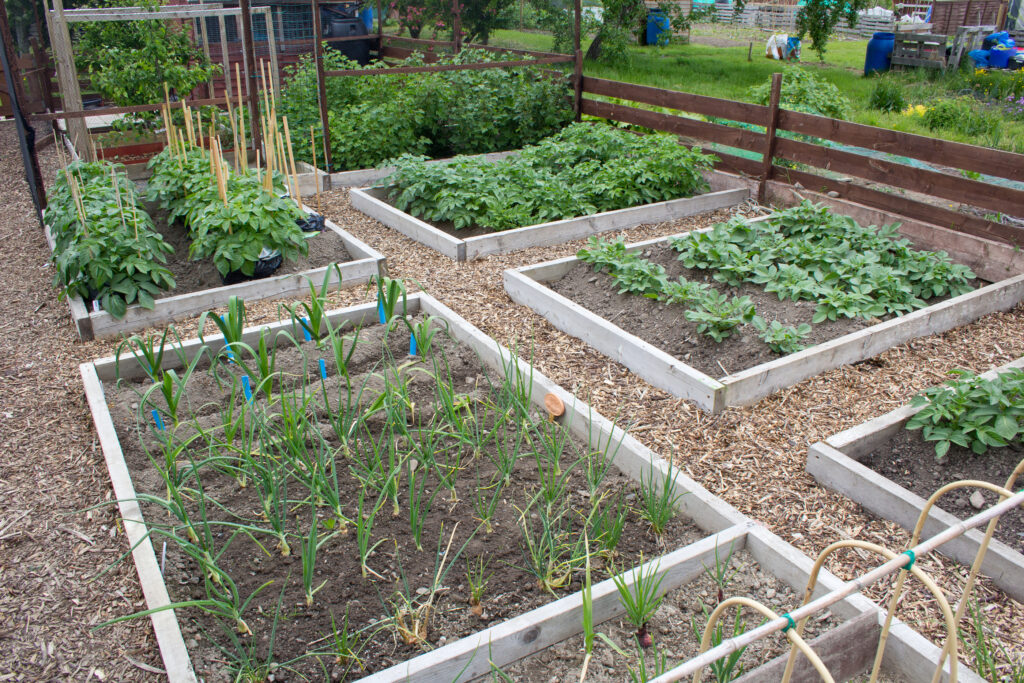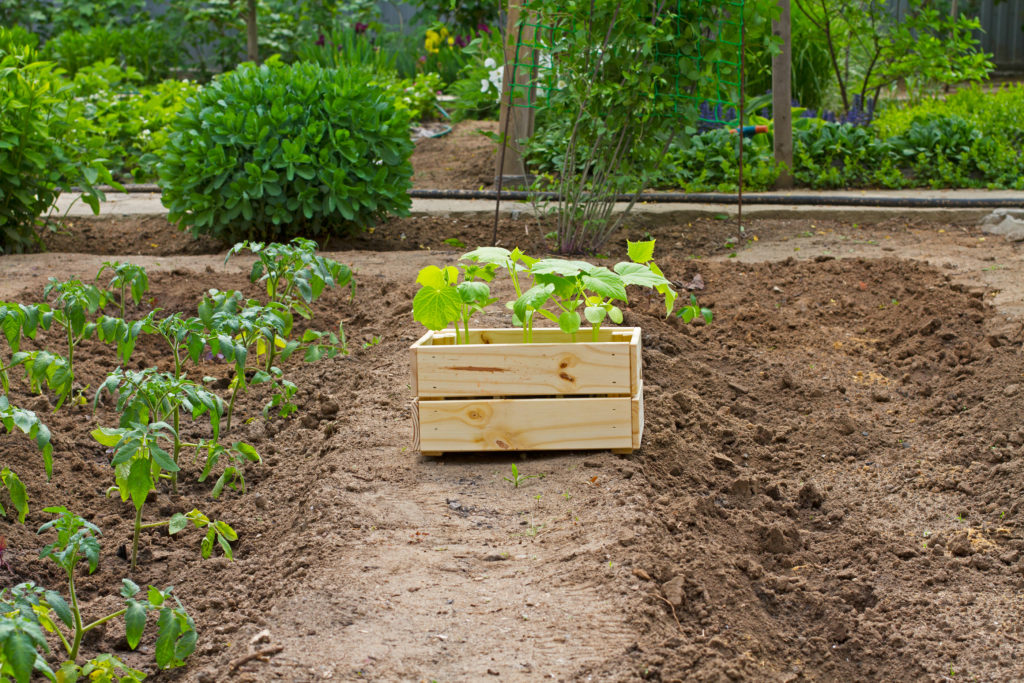Succession cropping is the planting of two or more crops in the same space at different times: a second crop succeeds a first as soon as possible after harvest and in some regions, a third crop can succeed the second after harvest. Succession planting is the practice of planting a new crop in the same spot where another crop has just been harvested.
Each crop in succession planting must come to harvest during its optimal harvest period. Cool-season crops grow best when the air and soil temperatures average 60 to75ºF (15-24ºC); they will stop producing when daytime temperatures exceed 80ºF (27ºC). Warm-season crops grow best when the air and soil temperature average 70 to 85ºF (21-29ºC); they should be protected from temperatures below 50ºF (10ºC) as they reach maturity.
Good Products for Growing Pest and Disease Control at Amazon:
- Garden Safe Snail and Slug Bait
- Bonide Sulfur Fungicide
- Monterey BT Caterpillar Killer
- Neem Bliss 100-% Cold Pressed Neem Oil
- Safer Brand Insect Killing Soap
- PyGanic Botanical Insecticide
Planning is essential for succession cropping. First, consider the temperature requirements of each crop (is it a cool-season crop or a warm-season crop?); second, consider the number of days to maturity that each crop requires; third, consider the average daytime temperatures over the next 30 to 90 days to make sure each crop reaches harvest in its optimal temperature range.

A common succession would be to plant a cool-season crop in early spring, followed by a warm-season crop in late spring or early summer, and succeeding with another cool-season crop in mid-to-late summer.
Use average days to maturity for cool- and warm-season crops to plan succession crops. To get the most out of the growing season, plant the first crop as early as possible in spring—setting out transplants or starts for some crops may be more speedy than sowing seed.
Spring cool-season crops for succession planting
The crop is followed by the number of days to harvest.
- Beets: 50 to 60 days from seeding
- Broccoli: 55 to 70 days from setting out plants
- Cabbage, Chinese: 45 to 60 days from setting out plants
- Cabbage, early: 40 to 50 days from setting out plants
- Carrots, baby types: 50 days from seeding
- Carrots, large varieties: 70 days from seeding
- Cauliflower: 45 to 60 days from setting out plants
- Leaf lettuce: 45 days from seeding
- Spinach: 40 to 50 days from seeding
Warm-season crops to follow spring cool-season crops
The crop is followed by the number of days to harvest.
- Beans, bush: 45 to 60 days from planting seed
- Corn, early sweet: 60 to 75 days from seeding
- Squash, summer: 45 to 50 days from seeding
- Tomatoes, early or determinate: 50 to 60 days from setting out plants

Succession planting summer into autumn
Succession plantings for autumn harvest are made in early- and mid-summer.
Crops for succession planting in early- and mid-summer are cool-season crops—crops that mature and yield best when temperatures average in the 60s and 50sF, not the 70s and 80sF, temperatures preferred by warm-season crops.
Crops to plant for the autumn harvest include snap beans, lima beans, cabbage, carrots, Chinese cabbage, beets, broccoli, cauliflower, kale, lettuce, bunching onions, radish, spinach, winter squash, and turnips. Warm-season crops can be succession plantings but the weather must stay warm enough into autumn for them to ripen.
Successful succession cropping requires timing: make sure there is enough time for the succession crop to germinate and grow to maturity before cold weather arrives. (Check the seed packet to learn how long a crop will take to germinate and reach maturity, then make sure there are enough days left in the season before the date of the average first frost in your area.) A frost and freeze will knock down and even kill some cool-season crops, but some cool-season crops can survive a frost or freeze if they are close to maturity and harvest.
When choosing succession crops, be sure that they get enough sunlight and are not shaded out by neighboring warm-season crops nearing maturity.
Here is a list of warm-season crops and suitable cool-season crops to follow in succession planting:
- Basil→ follow with lettuce, spinach, or peas.
- Snap Beans→ follow with lettuce, chard, or onions.
- Corn→ follow with beets, cabbage, collard, or lettuce.
- Cucumbers→ follow with peas, chard, or spinach.
- Eggplants→ follow with chard, lettuce, spinach, or bunching onions.
- Melons→ follow with peas, lettuce, kale, or spinach.
- Okra→ follow with spinach or lettuce.
- Onions→ follow with peas, lettuce, kale, or spinach.
- Peppers→ follow with lettuce, spinach, kale, bunching onions, or Chinese cabbage.
- Potatoes→ follow with peas, lettuce, spinach, kale, or bunching onions.
- Summer squash and zucchini→ follow with peas, lettuce, spinach, or Chinese cabbage.
- Sweet potatoes→ follow with peas, lettuce, kale, or spinach.
- Tomatoes→ follow with peas, lettuce, spinach, bunching onions, or Chinese cabbage.

Succession planting for winter harvest and storage
Succession planting in the home vegetable garden will supply the table not only through the summer months but also for late fall and winter. Plan and plant in late spring and early summer succession crops for harvest from fall through early spring.
Succession planting is the planting of one crop immediately after the harvest of another. Succession planting is also called succession cropping.
Cool region successions
Crops planted in summer for the late fall harvest in cool regions include beans, cauliflower, corn, cucumbers, endive, lettuce, peas, radishes, and green tomatoes for pickling and ripening after frost.
Vegetables that can be started in summer for winter are beets, Brussels sprouts, cabbages, carrots, cauliflower, celery, parsnips, potatoes, pumpkins, salsify, squash, and turnips.
Warm region successions
In warm-winter regions, heat-loving vegetables can be planted in early summer for harvest in fall (when the weather is often still hot). Crops for warm regions include summer squash, eggplant, peppers, cucumbers, tomatoes, corn, green beans, and chard.
Crops for winter storage
Harvesting crops at the right stage of development is the key to success for both fresh serving and storing. To taste best and to store best, vegetables should be matured but not fully developed at harvest.
After reaching maturity vegetables undergo a ripening process that precedes decay. In the case of root crops, for example, the start of decay is accompanied by toughening plant fibers, “stringiness” and general deterioration of table quality.
Plant crops for winter use with the idea of having vegetables reach good table size by the date you wish to harvest for winter storage. The planting date will vary with local climatic conditions just as spring planting does. When planning succession planting dates keep in mind the days to maturity for each crop and the date of the first expected frost in autumn. Crops must be planted to have time to develop before freezing weather.
Crops suitable for late sowing
Choose early and extra early varieties for succession cropping. Early and extra-early varieties come to harvest more quickly than other mid and late-season varieties of the same crop.
Sowing succession crops in dry weather
Dry weather or poor soil at the time of sowing may delay things so that the crop will fail to come through on time. Soil amended with aged compost will be both rich in nutrients and hold moisture in droughty conditions. Keep the soil evenly moist throughout the growing season.
Success in sowing or transplanting in dry weather frequently hinges upon getting the soil pressed firmly around the seeds or plant roots. Use the butt of your hand or a roller to lightly press the soil. Bean and pea seeds are particular about having good contact with the surrounding soil. If the weather is very dry, moisten the sowing bed or apply water to before setting in transplants.
Related article:
Succession Planting — Be An Expert
Garden Planning Books at Amazon:
- Vegetable Garden Grower’s Guide
- Tomato Grower’s Answer Book
- Vegetable Garden Almanac & Planner
- Kitchen Garden Grower’s Guide Vegetable Encyclopedia















